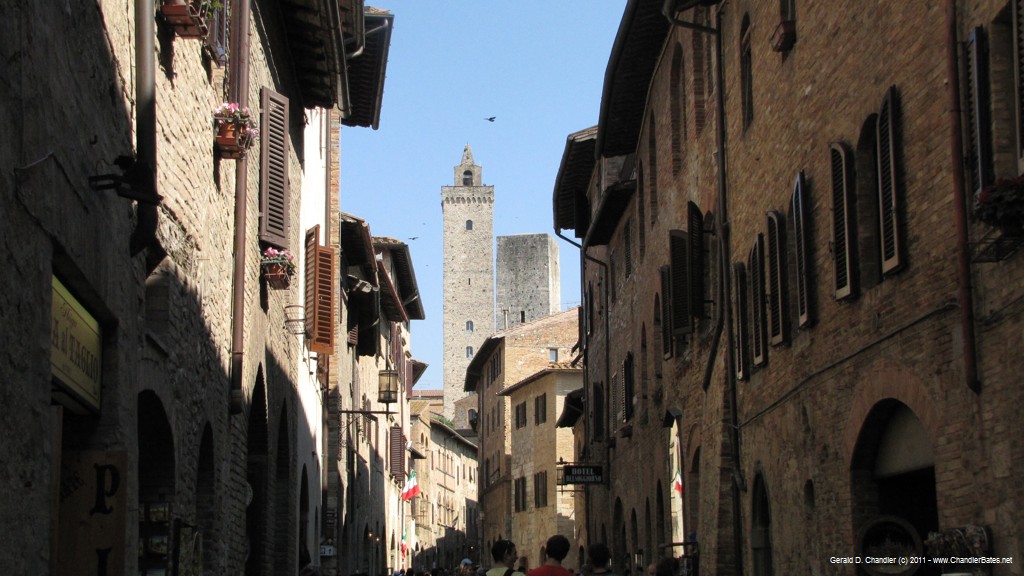Home | Front Page | Blog | Index | New | Contact | Site Map
![]() Florence
Florence
![]() Lucca
Lucca
![]() Siena
Siena
![]() Pisa
Pisa
![]() San Gimignano
San Gimignano
![]() Prato
Prato
![]() Bologna
Bologna
![]() Orvieto
Orvieto
![]() Assisi
Assisi
![]() Urbino
Urbino
![]() Ravenna
Ravenna
![]() Parma
Parma
![]() Milan
Milan
![]() Bergamo
Bergamo

2011 Cities & Stays
2010 Cities & Stays
2009 Cities & Stays
2011 Front Pages
2010 Front Pages
2009 Front Pages
2008 Front Pages
2007 Front Pages
2006 Front Pages
- 2006.12.12
- 2006.11.21
- 2006.11.04
- 2006.10.23
- 2006.10.09
- 2006.09.26
- 2006.09.10
- 2006.07.15
- 2006.05.30
- 2006.01.01

San Gimignano Main Street |
San Gimignano is a lovely little hilltop town, devoted mostly to tourism of course, because it is largely untouched by modern buildings if not by modern technology; it has very romantic winding old streets, and has great views across the countryside, like most hilltop towns. San Gimignano's ace in the hole, however, is that it also.has a cathedral that is about 80% frescoes, including two by Ghirlandaio. Some people think that the genius in them is thanks to Ghirlandaio's brother-in-law Domenico Mainardi. I don't buy it having seen the Ghirlandaio frescoes in Florence, but then I am no expert on the matter.
It is hard to imagine the beauty of a frescoed church if you have never seen one. Until we came to Florence, we had never done so and were absolutely stunned by the sight of these vibrant colorful images of 15th century Italy. painted directly onto the walls of churches. Sadly, many of them in the large churches of Florence were painted over, or simply removed to give way to the new baroque fashion of plain walls punctuated by architectonic altars. That is why the San Gimignano cathedral and its ilk are so precious.
The cathedral in San Gimignano is quite small by cathedral standards. Each side wall of the nave is covered floor to ceiling and cheek by jowl with a dozen or so frescoes depicting scenes from either the Old or New Testament. They were originally painted by a group of Florentine artists, including the above-mentioned Mainardi and Domenico Ghirlandaio, but some of the frescoes have been damaged and others changed through over-painting to the point of being un-restorable, which is a shame. If only 16th century Florence had had modern restoration techniques and the ability to remove frescoes safely from their walls, we might today have a whole lot more of these wonderful works of art.
The other heavily frescoed church, San Agostino, was also very much worth a visit. Some of its frescoes were by the above-mentioned Mainardi frescoes and incljuded a chapel of frescoes that is rather superb telling the story of St Augustine's life.
Getting to San Gimignano was a little bit of a challenge. When we arrived at the nearby train station of Poggi-Bonsi (honestly, that is the name of the town!), we had to find the bus and a place to buy tickets. It tunred out to be the train station newspaper stand. Wisely, in retrospect, we bought round-trip tickets at the outset. It locked us into the bus, but meant that we weren't thrown off the bus back to Poggi-Bonsi like some people who didn't know (how could they?) the bus driver would not sell them tickets. We spent a very full day wandering the town, grabbing a snack for lunch, and finding time to visit a small town museum as well. The journey home, started out uncomfortably, with about half of SG's tourists all trying to catch the same bus back to the railhead meaning that the bus was very crowded. We counted among the lucky ones who had a seat for the rather windy and bumpy ride down the San Gimignano hill. Catching the train was no problem and once back at Santa Maria Novella train station it was all plain-sailing as we had done the trip so many times before.